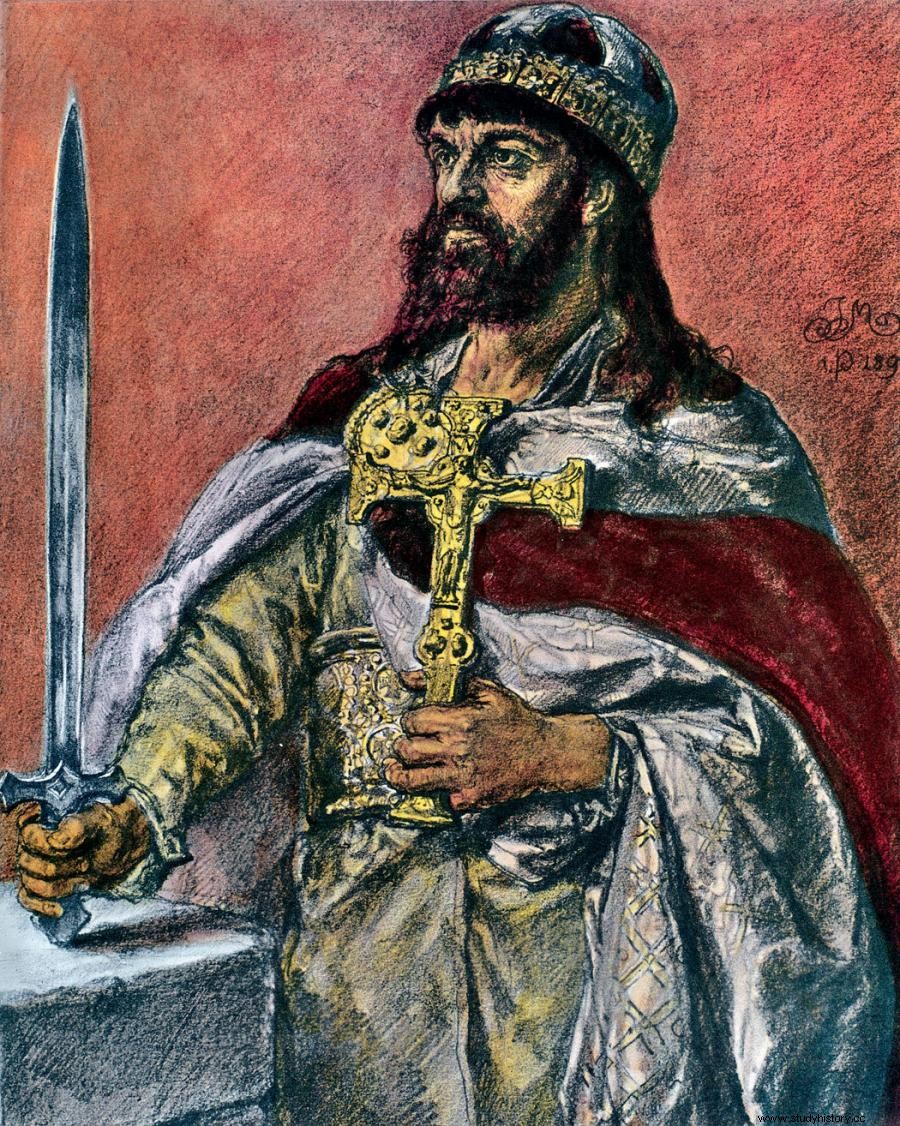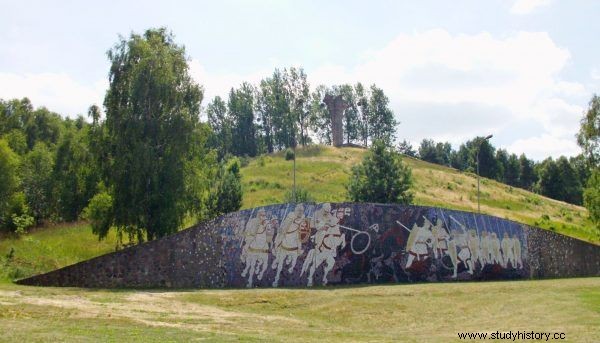The first confrontation with Germany became a myth. And, as is the case with myths, in the descriptions of the Battle of Cedynia there are more distortions, fantasies and pious wishes than hard facts.
The Battle of Cedynia is known from two accounts. Only Thietmar had described it in any detail. The hierarchy of the German church, who formed at the beginning of the 11th century, sat on the episcopal throne in Merseburg, i.e. on the Slavic frontier and not far from the Piast border.
Overall, it is assumed that he was well informed about Polish-German relations. In the pages of an extensive chronicle, he provided many details about the Polish ruler, his customs and spouse. He knew the battle of 972 exceptionally well, because he was told about it by the direct participant in the battle.
As Thietmar, one of the administrators of the German border, Margrave Hodo, noted, "having gathered the army, he attacked Mieszko with him":
Only my father, Count Siegfried, then a young man and not yet married, rushed to help the margrave with his [people]. When on St. John the Baptist clashed with Mieszko, won at first the victory, but then in a place called Cidini, his brother Czcibor [Cideburus] defeated them, putting all the best knights dead, except for the aforementioned graphs.
The second mention of the clash comes from the notes of Bruno of Kwerfurt - a missionary known as the great Polonophile and friend of another Piast ruler, Bolesław the Brave. Bruno - like Thietmar - was born a few years after the battle.

Thanks to Thietmar's chronicle, we know the German version of what happened in 972.
However, while Bishop Merseburg knew the German view on the subject, the itinerant preacher repeated the version adopted at the Polish ducal court. He wrote:
There was a war with the Polans; their prince, Mieszko, was victorious by trickery; The Teutons' humiliated pride had to lick the ground; the militant Margrave Hodo with torn banners rushed to run away.
Ambition and greed
The Battle of Cedynia is the first known military confrontation in Polish-German history, and the first triumph of Polish arms over the forces of its western neighbor. For these reasons alone, the battle has traditionally been given great importance.
According to the old (but still repeated!) Interpretation, Mieszko's opponent was the entire German empire, and the clash took place at the will of the emperor Otto the Great. Moreover, the defeat brought the Germans enormous humiliation and put the exposed Saxony at the mercy of Mieszko and his warriors. Not only was the scale of success emphasized, but also the size of the clash itself, in which not even hundreds but thousands of soldiers were to take part. This vision of the events of 972 penetrated the general consciousness. However, there is no underlying foundation for it.
What really happened? The chronicler Thietmar himself emphasized that the friendship between Mieszko and the emperor had not been broken, and the armed expedition was not the ruler's initiative. Nothing unusual. For several years, Otto did not even stay in Germany, but in Italy, where he engaged in the conquest of the former Roman Empire estates, in conflicts with Byzantium and in negotiations to ensure his young son's marriage with the eastern emperor. It was in the interest of the ruler to keep the peace in the north, if not permanently, then at least until he had closed other affairs and crossed the line of the Alps again.

You can read about the victories of our weapon in our latest book "Polish triumphs" . It is the perfect gift for any history buff. In all likelihood, he did it not only by surprise and in secret, but also completely arbitrarily. While no chronicle explains his reasoning, it seems that Hodon's actions can be reconstructed, at least in outline.

Even Thietmar emphasized that margrave Hodo attacked Mieszko without the emperor's consent.
Before being baptized, Prince Mieszko joined the war with the tribes inhabiting Pomerania. The conflict was fought with varying luck - initially the Piast leader suffered painful defeats; he even lost his brother, lying dead in one of the battles. Gradually, however, the scales of victory began to tilt to his side. In 967, Mieszko, supported by reinforcements from the Czech Republic, defeated the enemy forces, and then undertook a gradual conquest of Pomeranian towns.
By 972 the invasion seems to have been almost completed. Kołobrzeg, considered to be one of the most powerful centers on the Baltic Sea, fell into the hands of Piast. Wolin still defended itself - a real metropolis, half Viking in character. And in all likelihood it was the pagan Volinians, who caught the specter of the final catastrophe in their eyes, who in 972 entered into deals with a German margrave who was eager for promotion.
The Wolinians who survived the trade could offer Hodon silver, furs, slaves and decorative garments. In a word, tempt him with riches. The margrave probably also counted that thanks to the official tribute to one of the richest centers in Pomerania, he would immediately gain in the eyes of the emperor. He knew he was risking a lot. Failure would mean he would have to explain himself for the attack on the Imperial ally and Christian ruler. In the end, however, Hodon's ambition won with common sense and he agreed to help unexpected allies.
He won by trickery
There is no doubt about the fact that the campaign was prepared in a hurry. It seems just as certain that the margrave managed to field only a very limited contingent. Thietmar emphasized that almost nobody came to Hodon's call except his father. The date of the battle also says a lot - if it happened in June, the soldiers had to leave before the harvest, when the resources were almost finished, and the military was not able to eat at the expense of the hostile population.

The image of the battle between the Germans and the Slavs in the 11th century, on the relief in the Mainz Cathedral. Illustration and caption from the book "Polish triumphs".
Finally, it is also worth paying attention to the silence of the sources. Cedynia was included in the national resource of Polish myths, but in the 10th century the clash was not widely heard. Thietmar wrote about him, but mainly because of his father's participation in the clash. Other chroniclers did not even mention the battle, which would be completely unthinkable if hundreds of the finest soldiers died in the confrontation with the Slavs.
Apparently, there was not even a battle at Cedynia, but a skirmish in which both sides had small, hastily formed troops. The advantage of armaments was undoubtedly on the German side. It is possible that, in terms of numbers, Hodon was on top:after all, Mieszko had to go to meet him without any preparation, only with those warriors he had at hand, so as to cut his opponent's path as close as possible to the border.
The course of the clash is unknown, although many articles and books were devoted to it. What do we know with complete certainty? Bruno of Kwerfurt stressed that Mieszko had invoked deception, while Thietmar noted that the battle was divided into two strictly separate stages. First, the Poles suffered a defeat, then - they defeated the Germans chasing them. Historians draw the conclusion from these weak premises that the Piast prince used the same tactics that brought him triumph five years ago in the decisive clash with the Wolinians. Then Mieszko divided his army into two parts and, simulating the escape of one of the units, he hit the rear of the enemy with the use of the other one. I think he did the same now.
Just that… and so much
A small squad led directly by him made contact with the enemy and after a short fight he deliberately began to withdraw. The Germans chased him, driving deep into the hostile lands and losing sight of the terrain. Unexpectedly, reserve troops under the command of the prince's brother Czcibor hit their flanks or rear. Hodon's army, taken in the pinch, stood no chance.

Monument commemorating the alleged battlefield of 972
Mieszko's personal command over the forward unit was probably aimed at lulling the enemy's vigilance. It can also be assumed that the second part of the battle took place after the armies of both sides had traveled a longer distance, which on the one hand exhausted the enemy, and on the other hand stretched his ranks and made it difficult for Hodon to command. The success was complete.
Much more cannot be said about the battle itself. Everything else that has been written about this clash over the years is just guesswork or even loose fantasies. Details of the fight are not known. It is impossible to describe the sculpture of the battlefield, although it was freely done by the supposed experts on the subject in the past. Honestly, you can't even say where that skirmish took place.
It is known, however, that its effects turned out to be significant and far-reaching. It was a minor skirmish that quickly exacerbated Polish-German relations. Duke of Mieszko, she convinced him that he had sufficient strength to meddle even in an armed manner in the affairs of his western neighbor. Soon after the unexpected death of Otto the Great, this view will be tested in practice.
Find out more:
- Filipowiak W., Cedynia in the times of Mieszko I , Poznań Publishing House, Poznań 1966.
- Janicki K., Iron ladies. The Women Who Built Poland , Znak Horyzont, Krakow 2015.
- Labuda G., Studies on the beginnings of the Polish state , vol. I, Scientific Publishers of the University of Adama Mickiewicza, Poznań 1987.
- Migdalski P., The meaning and location of the Battle of Cidini in the light of historiography [in:] Civitas Schinesghe. Mieszko I and the beginnings of the Polish state , edited by Jan Maria Piskorski, Poznań Society of Friends of Sciences, Poznań – Gniezno 2004.
- Piskorski J.M., Tribal Pomerania . History - Archeology - Linguistics , Sorus, Poznań – Szczecin 2002.
- Rochala P., Cedynia 972 , Bellona, Warsaw 2002.
- Strzelczyk J., Mieszko the First , Abos Publishing House, Poznań 1992.
- Strzelczyk J., Otto the Great , Poznań Publishing House, Poznań 2018.
